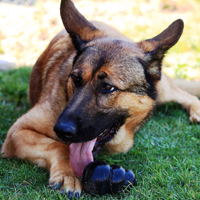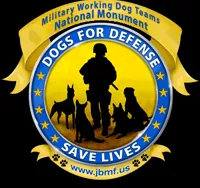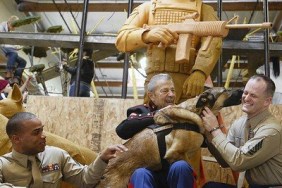This Memorial Day, as we honor U.S. service members who have made the ultimate sacrifice to protect our homeland and our freedoms, it is important to remember the four-legged heroes who serve or have served in the United States Armed Forces.
Early last year, DogTime.com told you about a landmark piece of legislation called the Canine Members of the Armed Forces Act. The act, which was also called Senate Bill 2134 and House Bill 4103, was important to Military Working Dog (MWD) rights for three reasons:
The act would require retired MWDs to be transported to the 341st Training Squadron at the Lackland Air Force Base in San Antonio, Texas, or another suitable location where the dogs can be placed up for adoption.
- The act would require the establishment of a system for the veterinary care of retired military working dogs.
- The act would name MWDs official members of the U.S. Armed Forces, allowing dogs who perform great acts of courage or merit during deployments to be recognized and decorated for their service.
- The House of Representatives passed House Bill 4103 in the spring of 2012, with the Senate following suit and approving Senate Bill 2134 in the fall.
But as the Canine Members of the Armed Forces Act became attached to the larger National Defense Authorization Act for 2013, a key part of the legislation was noticeably omitted before the President signed on the dotted line.
“The Senate did not pass the full resolution,” says President of the United States War Dog Association Ron Aiello.
While retired MWDs are now guaranteed transportation and veterinary medical care so they can have the chance at a good home after returning to the U.S. from their deployments, the last part of the act — which would require MWDs to be classified as service members and decorated in a way that reflects their service and sacrifice — was left out.
“It was decided by the Senate that to get the bill passed they had to take out a portion of it. That portion was the reclassification of the Military Working Dogs from Equipment to Canine Members of the Armed Forces,” Aiello explains.
So while MWDs often go through rigorous training, detect deadly explosives, parachute into enemy territory, guard against attacks, and dodge bullets and risk their lives right alongside their human handlers, these dogs are not given the same recognition as other soldiers, simply because they walk on four legs instead of two.
That means former MWDs like Brit are considered equipment and not canine service members, and that is not okay with his adopted owner, who stresses Brit’s courage in serving with the military.
“Those dogs should be considered a soldier and not just a computer, a desk, a number, and this is all they are,” military wife and Brit’s owner, Jasmine Russell, tells WRAL.com.
Brit once served as a narcotics dog for the U.S. military, but a leg injury forced the brave dog into retirement. Russell adopted Brit and was struck right away with his loving personality. “A lot of people, when they hear military working dogs, they automatically think fangs, teeth, mean, vicious, they can take somebody apart,” she says, “and we want to show [them], this is not the case.”
Brit is now a licensed therapy dog, and he accompanies Russell to the Womack Army Medical Center on Fort Bragg to visit with injured troops.
“If you watch [Brit], he loves soldiers,” says Russell. “The uniform is a magnet to him.”
Co-sponsors of the Canine Members of the Armed Forces Act, Representative Walter Jones (R-NC) and Senator Richard Blumenthal (D-CT), vow to reintroduce the reclassification issue in Congress soon.
“We’re going to continue to push,” says Rep. Jones, “and [Secretary of Defense Chuck Hagel] has the authority, if he determines that we should reclassify.”
We should take care of the brave MWDs who make it home, ensure they can enjoy their retirement, but we should also remember those dogs who lost their lives keeping other soldiers safe.
“These dogs are very special for those men and women who have been fighting for this country,” Rep. Jones adds, “who have seen these animals give their life for their comrades. They are very special.”
Sources: WRAL.com, GovTrack.US, Khanrahan.com









